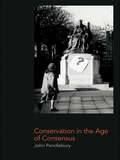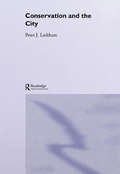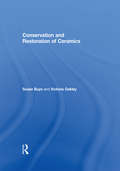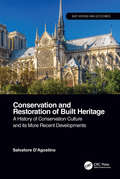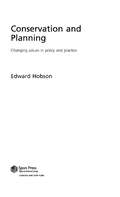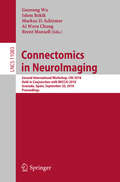- Table View
- List View
The Conservation Movement: Antiquity to Modernity
by Miles GlendinningWinner of the 2016 Antoinette Forrester Downing Award presented by the Society of Architectural Historians. In many cities across the world, particularly in Europe, old buildings form a prominent part of the built environment, and we often take it for granted that their contribution is intrinsically positive. How has that widely-shared belief come about, and is its continued general acceptance inevitable? Certainly, ancient structures have long been treated with care and reverence in many societies, including classical Rome and Greece. But only in modern Europe and America, in the last two centuries, has this care been elaborated and energised into a forceful, dynamic ideology: a ‘Conservation Movement’, infused with a sense of historical destiny and loss, that paradoxically shared many of the characteristics of Enlightenment modernity. The close inter-relationship between conservation and modern civilisation was most dramatically heightened in periods of war or social upheaval, beginning with the French Revolution, and rising to a tragic climax in the 20th-century age of totalitarian extremism; more recently the troubled relationship of ‘heritage’ and global commercialism has become dominant. Miles Glendinning’s new book authoritatively presents, for the first time, the entire history of this architectural Conservation Movement, and traces its dramatic fluctuations in ideas and popularity, ending by questioning whether its recent international ascendancy can last indefinitely.
Conservation in the Age of Consensus
by John PendleburyThis new text on the subject of conservation in the built environment provides a unique holistic view on the understanding of the practice of conservation connecting it with wider societal and political forces. UK practice is used as a means, along with international examples, for bringing together a real understanding of practice with a social science analysis of the issues. The author introduces ideas about the meanings and values attached to historic environments and how that translates into public policies of conservation.
Conservation in the Age of Consensus
by John PendleburyThis new text on the subject of conservation in the built environment provides a unique holistic view on the understanding of the practice of conservation connecting it with wider societal and political forces. UK practice is used as a means, along with international examples, for bringing together a real understanding of practice with a social science analysis of the issues. The author introduces ideas about the meanings and values attached to historic environments and how that translates into public policies of conservation.
Conservation and the City
by Peter LarkhamIt is a widely held belief that cities must change, or they will wither and die. One of the key problems of urbanization is how to cope with these changes while retaining the structures constructed and maintained by previous generations. Conservation and the City is a study of conservation and change throughout the built environment - city centres, suburbs and even tiny villages - and how the activites of conservation interact with the planning system. Using detailed case studies from Britain and the Westernized world, the author examines some of the key social, economic and psychological ideas which support conservation, as well as studying the urban landscape and the agents of change. Conservation and the City seeks to understand urban conservation, and in doing so presents possible solutions for managing change in the built environment of the future.
Conservation and the City
by Peter LarkhamIt is a widely held belief that cities must change, or they will wither and die. One of the key problems of urbanization is how to cope with these changes while retaining the structures constructed and maintained by previous generations. Conservation and the City is a study of conservation and change throughout the built environment - city centres, suburbs and even tiny villages - and how the activites of conservation interact with the planning system. Using detailed case studies from Britain and the Westernized world, the author examines some of the key social, economic and psychological ideas which support conservation, as well as studying the urban landscape and the agents of change. Conservation and the City seeks to understand urban conservation, and in doing so presents possible solutions for managing change in the built environment of the future.
Conservation and Restoration of Glass
by Sandra Davison R.G. NewtonConservation and Restoration of Glass is an in-depth guide to the materials and practices required for the care and preservation of glass objects. It provides thorough coverage of both theoretical and practical aspects of glass conservation.This new edition of Newton and Davison's original book, Conservation of Glass, includes sections on the nature of glass, the historical development and technology of glassmaking, and the deterioration of glass. Professional conservators will welcome the inclusion of recommendations for examination and documentation. Incorporating treatment of both excavated glass and historic and decorative glass, the book provides the knowledge required by conservators and restorers and is invaluable for anyone with glass objects in their care.
Conservation and Restoration of Glass (Butterworth-heinemann Series In Conservation And Museology)
by Sandra Davison R.G. NewtonConservation and Restoration of Glass is an in-depth guide to the materials and practices required for the care and preservation of glass objects. It provides thorough coverage of both theoretical and practical aspects of glass conservation.This new edition of Newton and Davison's original book, Conservation of Glass, includes sections on the nature of glass, the historical development and technology of glassmaking, and the deterioration of glass. Professional conservators will welcome the inclusion of recommendations for examination and documentation. Incorporating treatment of both excavated glass and historic and decorative glass, the book provides the knowledge required by conservators and restorers and is invaluable for anyone with glass objects in their care.
Conservation and Restoration of Ceramics (Butterworth-heinemann Series In Conservation And Museology Ser.)
by Susan Buys Victoria OakleyThe Conservation and Restoration of Ceramics brings together the wide range of current information relevant to the practising conservator. The book opens with a discussion of the fundamental nature of the ceramic medium, information which is of primary importance when selecting treatments or considering preventive conservation measures. Details on techniques are given in a series of chapters covering the restoration and conservation processes, but the emphasis is on the basic principles involved in the choice of materials and methods. The nature and properties of materials commonly in use are fully discussed and guidance is given on the facilities and equipment needed.Also covered in the book are old restoration materials and methods, the ethics of ceramics conservation, examination and recording, display treatments and emergency procedures.Now in paperback, this book will be invaluable to practising conservators and readers of conservation as well as of interest to museum curators and collectors.
Conservation and Restoration of Ceramics
by Susan Buys Victoria OakleyThe Conservation and Restoration of Ceramics brings together the wide range of current information relevant to the practising conservator. The book opens with a discussion of the fundamental nature of the ceramic medium, information which is of primary importance when selecting treatments or considering preventive conservation measures. Details on techniques are given in a series of chapters covering the restoration and conservation processes, but the emphasis is on the basic principles involved in the choice of materials and methods. The nature and properties of materials commonly in use are fully discussed and guidance is given on the facilities and equipment needed.Also covered in the book are old restoration materials and methods, the ethics of ceramics conservation, examination and recording, display treatments and emergency procedures.Now in paperback, this book will be invaluable to practising conservators and readers of conservation as well as of interest to museum curators and collectors.
Conservation and Restoration of Built Heritage: A History of Conservation Culture and its More Recent Developments (Built Heritage and Geotechnics)
by Salvatore D'AgostinoThe word conservation, when used in the context of the preservation of built heritage, implies an intrinsically complex concept that evolved over time, since it has been influenced by the perception of history throughout time. This volume emphasises why an understanding of the cultural evolution of the conservation approach must be considered a prerequisite for architects and engineers if they are to cooperate in full harmony with historic-artistic culture for the preservation of global built heritage. In particular, the volume highlights how, during the second half of the last century, the preservation process also involved engineering – the science of making practical applications of knowledge – which, for a long time, made an uncritical use of techniques and materials and devised interventions on historical heritage that were heavily invasive. The volume also devotes special attention to the problems related to seismic risk, to which Italy, Greece and Portugal are particularly prone. Problems that emerge during the crisis and reconstruction phases are dealt with in detail, as is scheduled maintenance, as this latter approach always constitutes an improvement in the performance of the monument and is the most appropriate tool for the conservation of the built heritage. Finally, the volume collects examples of building restoration with case studies of many outstanding monuments. The work will appeal to professionals and academics in the broader fields of civil engineering (both geotechnical and structural engineering), architecture, art history, the history of architecture, restoration and cultural heritage management. This book will: Provide a critical reading of the history of conservation; Discuss materials and techniques of ancient architecture; Cover seismic vulnerability and preservation of the historic integrity of the monument; Advocate an approach based on programmed maintenance; Feature numerous case histories, including St Mark’s Basilica in Venice and the complex restoration of the cathedral of Notre-Dame in Paris.
Conservation and Restoration of Built Heritage: A History of Conservation Culture and its More Recent Developments (Built Heritage and Geotechnics)
by Salvatore D'AgostinoThe word conservation, when used in the context of the preservation of built heritage, implies an intrinsically complex concept that evolved over time, since it has been influenced by the perception of history throughout time. This volume emphasises why an understanding of the cultural evolution of the conservation approach must be considered a prerequisite for architects and engineers if they are to cooperate in full harmony with historic-artistic culture for the preservation of global built heritage. In particular, the volume highlights how, during the second half of the last century, the preservation process also involved engineering – the science of making practical applications of knowledge – which, for a long time, made an uncritical use of techniques and materials and devised interventions on historical heritage that were heavily invasive. The volume also devotes special attention to the problems related to seismic risk, to which Italy, Greece and Portugal are particularly prone. Problems that emerge during the crisis and reconstruction phases are dealt with in detail, as is scheduled maintenance, as this latter approach always constitutes an improvement in the performance of the monument and is the most appropriate tool for the conservation of the built heritage. Finally, the volume collects examples of building restoration with case studies of many outstanding monuments. The work will appeal to professionals and academics in the broader fields of civil engineering (both geotechnical and structural engineering), architecture, art history, the history of architecture, restoration and cultural heritage management. This book will: Provide a critical reading of the history of conservation; Discuss materials and techniques of ancient architecture; Cover seismic vulnerability and preservation of the historic integrity of the monument; Advocate an approach based on programmed maintenance; Feature numerous case histories, including St Mark’s Basilica in Venice and the complex restoration of the cathedral of Notre-Dame in Paris.
Conservation and Planning: Changing Values in Policy and Practice
by Edward HobsonConserving historic buildings continues to excite and inflame opinion. The means of protecting such buildings and areas are well established but frequently suffer a lack of wider understanding. Conservation and Planning takes a detailed look at the way these processes have evolved and their use today by policy makers and local decision makers.This book presents original research into how national and local decision-makers construct and implement conservation of the built environment. The findings in this book challenge many of the assumptions supporting conservation.
Conservation and Planning: Changing Values in Policy and Practice
by Edward HobsonConserving historic buildings continues to excite and inflame opinion. The means of protecting such buildings and areas are well established but frequently suffer a lack of wider understanding. Conservation and Planning takes a detailed look at the way these processes have evolved and their use today by policy makers and local decision makers.This book presents original research into how national and local decision-makers construct and implement conservation of the built environment. The findings in this book challenge many of the assumptions supporting conservation.
Conservation: RIBA Plan of Work 2013 Guide
by Hugh FeildenConservation is part of a brand new series providing must-read practical guidance to running efficient and successful projects using the new RIBA Plan of Work 2013. Each guide takes a particular angle – in this case the author guides you through working on a conservation project - and explains the essential activities required at each stage. Concise and easy to use with a consistent format these guides provide the ultimate quick reference support at your desk or on-site. This is an authoritative ‘how to’ full of pragmatic advice, examples and in-text features such as ‘hints and tips’ that illuminate best practice and clever solutions. Designed to be used on all projects – large and small – and across all types of procurement, they are task rather than role-oriented acknowledging that a variety of people take on these responsibilities. They are also invaluable for architectural students at Part 3 who are getting to grips with the realities of practice.
Conservation: RIBA Plan of Work 2013 Guide
by Hugh FeildenConservation is part of a brand new series providing must-read practical guidance to running efficient and successful projects using the new RIBA Plan of Work 2013. Each guide takes a particular angle – in this case the author guides you through working on a conservation project - and explains the essential activities required at each stage. Concise and easy to use with a consistent format these guides provide the ultimate quick reference support at your desk or on-site. This is an authoritative ‘how to’ full of pragmatic advice, examples and in-text features such as ‘hints and tips’ that illuminate best practice and clever solutions. Designed to be used on all projects – large and small – and across all types of procurement, they are task rather than role-oriented acknowledging that a variety of people take on these responsibilities. They are also invaluable for architectural students at Part 3 who are getting to grips with the realities of practice.
Conservation
by Alison Richmond Alison Bracker'Conservation: Principles, Dilemmas, and Uncomfortable Truths' presents multi-perspective critical analyses of the ethics and principles that guide the conservation of works of art and design, archaeological artefacts, buildings, monuments, and heritage sites on behalf of society. Contributors from the fields of philosophy, sociology, history, art and design history, museology, conservation, architecture, and planning and public policy address a wide range of conservation principles, practices, and theories from the US, Canada, Europe, Australia and New Zealand, encouraging the reader to make comparisons across subjects and disciplines. By wrestling with and offering ways of disentangling the ethical dilemmas confronting those who maintain and sustain cultural heritage for today and tomorrow, 'Conservation: Principles, Dilemmas, and Uncomfortable Truths' provides an essential reference text for conservation professionals, museum and heritage professionals, art and cultural historians, lecturers and students, and all others invested in cultural heritage theories and practices. Alison Richmond, as a Senior Conservator in the Victoria and Albert Museum and Deputy Head of the Conservation Department at the Royal College of Art, maintains teaching and research roles in conservation theory, principles and ethics, and has developed decision-making tools for conservators. She is an Accredited Conservator-Restorer (ACR), a Fellow of the International Institute for Conservation (FIIC), and a Trustee of the UK’s Institute of Conservation (Icon) since 2005. Alison Bracker received her PhD in the History of Art from the University of Leeds, and manages the Events & Lectures programme at the Royal Academy of Arts in London. As co-founder of Bracker Fiske Consultants, she advises on the presentation, description, documentation, and care of artworks comprising modern media, and lectures and publishes widely on the theoretical and practical issues arising from the conservation of non-traditional and impermanent materials in contemporary works of art.
Conservation
by Alison Richmond Alison Bracker'Conservation: Principles, Dilemmas, and Uncomfortable Truths' presents multi-perspective critical analyses of the ethics and principles that guide the conservation of works of art and design, archaeological artefacts, buildings, monuments, and heritage sites on behalf of society. Contributors from the fields of philosophy, sociology, history, art and design history, museology, conservation, architecture, and planning and public policy address a wide range of conservation principles, practices, and theories from the US, Canada, Europe, Australia and New Zealand, encouraging the reader to make comparisons across subjects and disciplines. By wrestling with and offering ways of disentangling the ethical dilemmas confronting those who maintain and sustain cultural heritage for today and tomorrow, 'Conservation: Principles, Dilemmas, and Uncomfortable Truths' provides an essential reference text for conservation professionals, museum and heritage professionals, art and cultural historians, lecturers and students, and all others invested in cultural heritage theories and practices. Alison Richmond, as a Senior Conservator in the Victoria and Albert Museum and Deputy Head of the Conservation Department at the Royal College of Art, maintains teaching and research roles in conservation theory, principles and ethics, and has developed decision-making tools for conservators. She is an Accredited Conservator-Restorer (ACR), a Fellow of the International Institute for Conservation (FIIC), and a Trustee of the UK’s Institute of Conservation (Icon) since 2005. Alison Bracker received her PhD in the History of Art from the University of Leeds, and manages the Events & Lectures programme at the Royal Academy of Arts in London. As co-founder of Bracker Fiske Consultants, she advises on the presentation, description, documentation, and care of artworks comprising modern media, and lectures and publishes widely on the theoretical and practical issues arising from the conservation of non-traditional and impermanent materials in contemporary works of art.
Consent in Shakespeare: What Women Do and Don’t Say and Do in Shakespeare’s Mediterranean Comedies and Origin Stories (Studies in Performance and Early Modern Drama)
by Artemis PreeshlBy examining how female characters speak and act during coming of age, engagement, marriage, and intimacy, Consent in Shakespeare will enhance understanding about how and why women spoke, remained silent, or acted as they did in relation to their intimate partners in Early Modern and contemporary private and public situations in and around the Mediterranean. Consent in intimate relationships is front and center in today’s conversations. This book re-examines the verbal and physical interactions of female-identified characters in Early Modern and contemporary cultures in Shakespeare’s Mediterranean comedies and the sources from which he derived his plays. This re-examination of the words that women say or do not say, and actions that women do or do not take, in Shakespeare’s Mediterranean plays and his probable sources sheds light on how Shakespeare’s audiences might have perceived Mediterranean cultural mores and norms. Assessment of source materials for Shakespeare’s comedies set in the Balkans, France, Italy, the Near East, North Africa, and Spain suggests how women of diverse backgrounds communicated in everyday life and peak life experiences in the Early Modern era. Given Shakespeare’s impact worldwide, this initiative to shift the conversation about the power of consent of female protagonists and supporting characters in Shakespeare’s Mediterranean plays will further transform conversations about consent in class, board and conference rooms, and the international stage.
Consent in Shakespeare: What Women Do and Don’t Say and Do in Shakespeare’s Mediterranean Comedies and Origin Stories (Studies in Performance and Early Modern Drama)
by Artemis PreeshlBy examining how female characters speak and act during coming of age, engagement, marriage, and intimacy, Consent in Shakespeare will enhance understanding about how and why women spoke, remained silent, or acted as they did in relation to their intimate partners in Early Modern and contemporary private and public situations in and around the Mediterranean. Consent in intimate relationships is front and center in today’s conversations. This book re-examines the verbal and physical interactions of female-identified characters in Early Modern and contemporary cultures in Shakespeare’s Mediterranean comedies and the sources from which he derived his plays. This re-examination of the words that women say or do not say, and actions that women do or do not take, in Shakespeare’s Mediterranean plays and his probable sources sheds light on how Shakespeare’s audiences might have perceived Mediterranean cultural mores and norms. Assessment of source materials for Shakespeare’s comedies set in the Balkans, France, Italy, the Near East, North Africa, and Spain suggests how women of diverse backgrounds communicated in everyday life and peak life experiences in the Early Modern era. Given Shakespeare’s impact worldwide, this initiative to shift the conversation about the power of consent of female protagonists and supporting characters in Shakespeare’s Mediterranean plays will further transform conversations about consent in class, board and conference rooms, and the international stage.
Consensus Design
by Rosie Parnell Christopher DayConsensus Design offers a practical step by step guide to co-design; an increasingly important consideration for architects as they compete for work.The text moves from identifying the methodology of the process to developing a series of principles and practical steps which illustrate how consensus design can be established. For easy reference, flow charts show the process of achieving consensus design and include variations for different types of project and different groups of people. It gives clear timings so that agreements can be reached within a specific time frame, and also features a number of case studies to illustrate consensus design principles in practice. Case studies include projects in the UK, US, and Sweden.Consensus design isn't just a utopian ideal. It's the only meaningful way in which people can be involved in shaping where they live and work. It can have an influence on social stability, crime-reduction, personal health and building longevity, all of which in turn have monetary and environmental cost implications. Its consideration can also greatly help architects win work and commissions.Day argues that when places are designed by professionals for people, many things obvious to the residents are overlooked. When they are designed by lay people, the design can suffer from the lowest common denominator factor. When places are designed by both it tends to end up in conflict. However, Consensus Design shows that co-design is not doomed to either conflict or banality if it is managed correctly.
Consensus Design
by Rosie Parnell Christopher DayConsensus Design offers a practical step by step guide to co-design; an increasingly important consideration for architects as they compete for work.The text moves from identifying the methodology of the process to developing a series of principles and practical steps which illustrate how consensus design can be established. For easy reference, flow charts show the process of achieving consensus design and include variations for different types of project and different groups of people. It gives clear timings so that agreements can be reached within a specific time frame, and also features a number of case studies to illustrate consensus design principles in practice. Case studies include projects in the UK, US, and Sweden.Consensus design isn't just a utopian ideal. It's the only meaningful way in which people can be involved in shaping where they live and work. It can have an influence on social stability, crime-reduction, personal health and building longevity, all of which in turn have monetary and environmental cost implications. Its consideration can also greatly help architects win work and commissions.Day argues that when places are designed by professionals for people, many things obvious to the residents are overlooked. When they are designed by lay people, the design can suffer from the lowest common denominator factor. When places are designed by both it tends to end up in conflict. However, Consensus Design shows that co-design is not doomed to either conflict or banality if it is managed correctly.
Connoisseurship
by Christina M. Anderson and Peter StewartDespite the central importance of connoisseurship in the rarefied world of art collecting, it occupies an uncomfortable position in modern scholarship. On the one hand, the concept retains a significant role in the study of art and the care of public and private collections when it is linked with art appreciation, qualities visible to the attuned eye, or the processes of attribution and authentication. On the other hand, the last century has seen connoisseurship marginalized in academic discourse: it is often associated with amateurism, social elitism, status-display, and intellectual mystification. The present collection of essays enters this breach and--by adopting a broad, interdisciplinary approach--considers connoisseurship afresh, investigating its practice in both familiar and unexpected places. Essays on the role of connoisseurship in Western art history appear alongside innovative, global perspectives on Chinese numismatics and walnut collecting, wine and coffee expertise, the market for geological specimens, and the parallels between Morellian connoisseurship and modern forensics. These essays resonate with one another in surprising ways and create new dialogues about connoisseurship's meaning and application, demonstrating that its practice can be both intuitive and scientific.
Connoisseurship
Despite the central importance of connoisseurship in the rarefied world of art collecting, it occupies an uncomfortable position in modern scholarship. On the one hand, the concept retains a significant role in the study of art and the care of public and private collections when it is linked with art appreciation, qualities visible to the attuned eye, or the processes of attribution and authentication. On the other hand, the last century has seen connoisseurship marginalized in academic discourse: it is often associated with amateurism, social elitism, status-display, and intellectual mystification. The present collection of essays enters this breach and--by adopting a broad, interdisciplinary approach--considers connoisseurship afresh, investigating its practice in both familiar and unexpected places. Essays on the role of connoisseurship in Western art history appear alongside innovative, global perspectives on Chinese numismatics and walnut collecting, wine and coffee expertise, the market for geological specimens, and the parallels between Morellian connoisseurship and modern forensics. These essays resonate with one another in surprising ways and create new dialogues about connoisseurship's meaning and application, demonstrating that its practice can be both intuitive and scientific.
Connectomics in NeuroImaging: First International Workshop, Cni 2017, Held In Conjunction With Miccai 2017, Quebec City, Qc, Canada, September 14, 2017, Proceedings (Lecture Notes in Computer Science #10511)
by Brent Munsell Ai Wern Chung Markus D. Schirmer Islem Rekik Guorong WuThis book constitutes the refereed proceedings of the Second International Workshop on Connectomics in NeuroImaging, CNI 2018, held in conjunction with MICCAI 2018 in Granada, Spain, in September 2018. The 15 full papers presented were carefully reviewed and selected from 20 submissions. The papers deal with new advancements in network construction, analysis, and visualization techniques in connectomics and their use in clinical diagnosis and group comparison studies as well as in various neuroimaging applications.
Connectomics in NeuroImaging: First International Workshop, CNI 2017, Held in Conjunction with MICCAI 2017, Quebec City, QC, Canada, September 14, 2017, Proceedings (Lecture Notes in Computer Science #10511)
by Guorong Wu Paul Laurienti Leonardo Bonilha Brent C. MunsellThis book constitutes the refereed proceedings of the First International Workshop on Connectomics in NeuroImaging, CNI 2017, held in conjunction with MICCAI 2017 in Quebec City, Canada, in September 2017. The 19 full papers presented were carefully reviewed and selected from 26 submissions. The papers deal with new advancements in network construction, analysis, and visualization techniques in connectomics and their use in clinical diagnosis and group comparison studies as well as in various neuroimaging applications.

